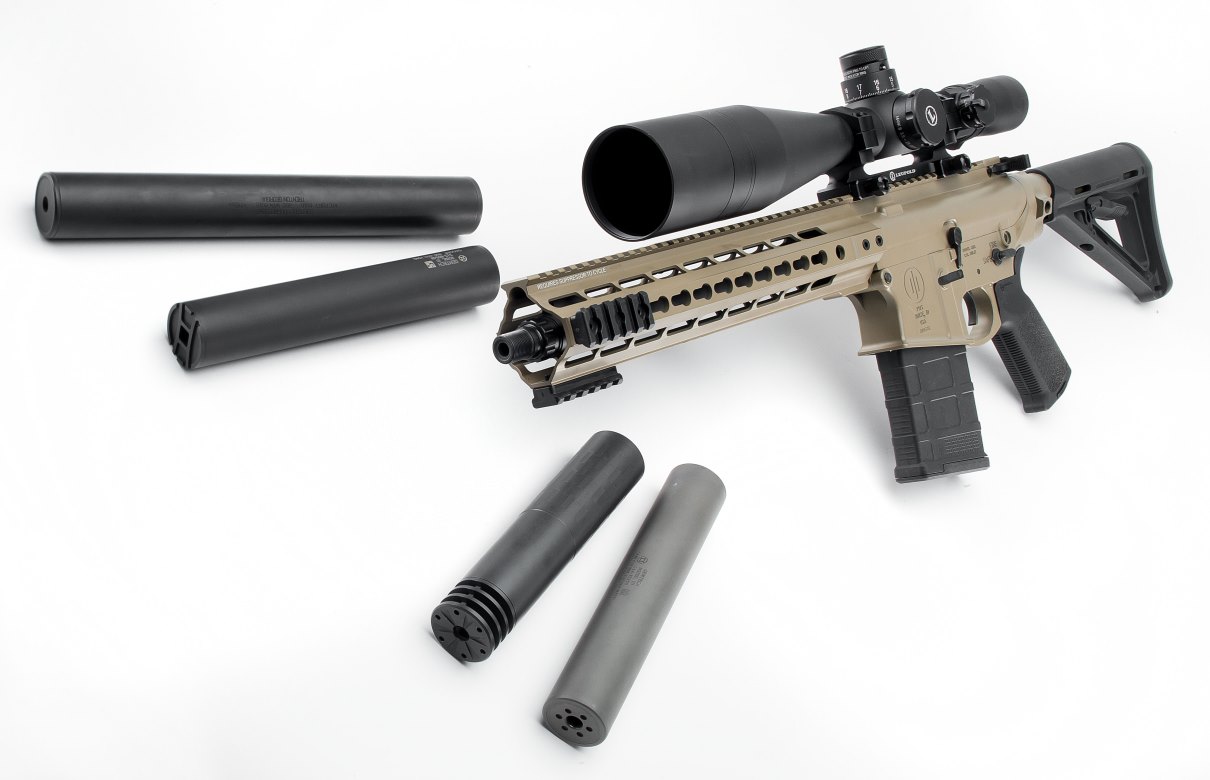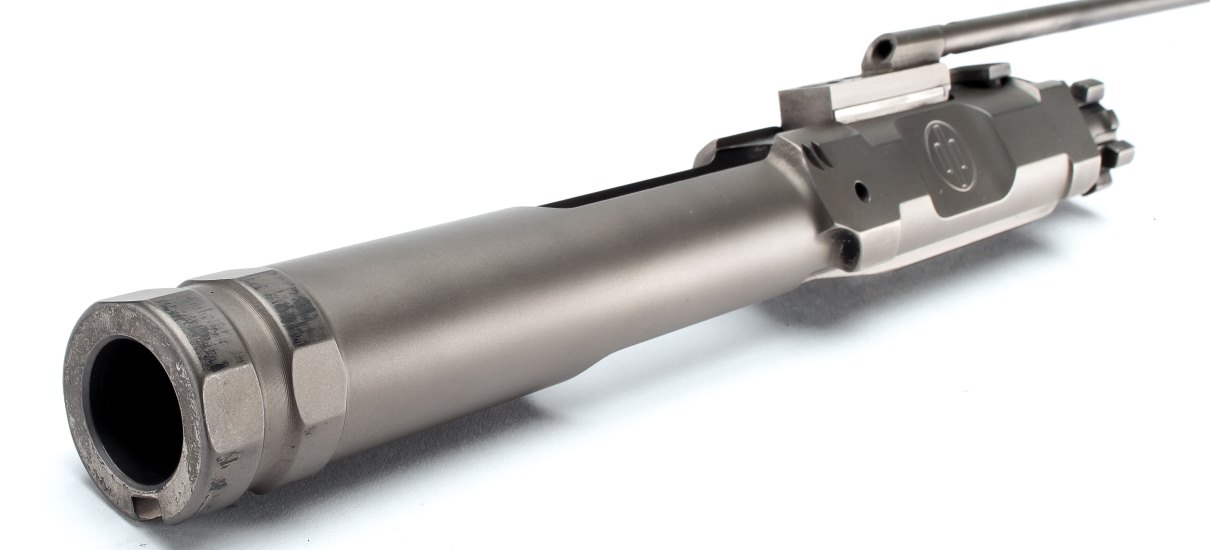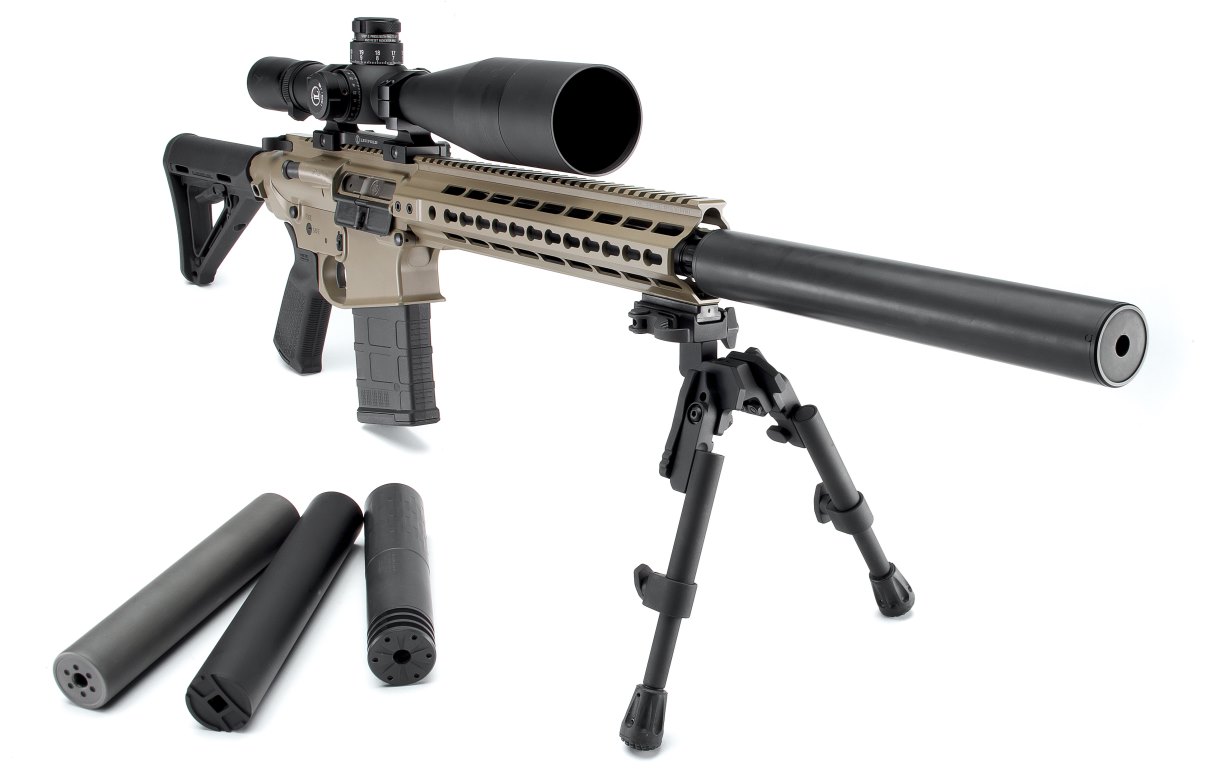Suppressed Sophistication
By: Sean Utley
 (Photo courtesy of "Shooting Times")
(Photo courtesy of "Shooting Times")
PWS MK212SD
Primary Weapons Systems (PWS) is one of the more understated manufacturers in the industry. With a quiet consistency, it churns out high-quality items that go the way of clean, elegant and modern, never over-the-top or in your face.
Though PWS is branching out into other cutting-edge products and technologies, at the time of this writing, one of those areas is not suppressor manufacturing. Instead, with the release of its MK212SD, a dedicated suppressed, short-barreled rifle chambered in .308, PWS is contributing to the suppressor world in a more indirect way.
Whenever you discuss PWS, you have to mention its unique and proven long-stroke piston system. It works as a one-piece op rod, and because of this design you have gases pushing against an op rod that connects to the rifle’s carrier. Short-stroke pistons have an op rod that butts up against the top of the carrier, and thus it’s not actually connected. The PWS system provides a smoother recoil impulse that’s like a push as opposed to a short stroke that may have a harsher, “whacking” type of impulse. This concept applies across both 5.56 and 7.62 platforms, but I really noticed it when shooting the company’s MK212 SBR recently. That rifle really pushed into the shoulder without being abusive, even with a 13½-inch barrel. It produces an impulse on par with a well-sorted direct impingement gun, with the cleaner and cooler functioning benefits of the piston system.

The PWS BCG is machined for minimal contact and maximum efficiency of operation. (Photo courtesy of “Shooting Times”)
The SD designation on this MK212 stands for “suppression dedicated.” The MK212SD will not function without a suppressor affixed to its 13.1-inch barrel. The MK212SD is gassed to run efficiently and appropriately with a suppressor attached instead of becoming overgassed and beating itself to pieces. The need for appropriate gas tuning for suppression seems to be even more critical and pronounced in .308 rifles. The piston configuration helps further the cleanliness of the MK212SD, since gases are vented out at the front of the op rod.
PWS’ standard MK212 utilizes an adjustable gas block, but the company went a step further with the MK212SD. It runs on a gas system dialed in to work optimally only when a suppressor is attached. This should mean a smoother-running, softer-shooting (less-recoiling) suppressed rifle. As stated in PWS’ literature, “The MK212SD is configured for the lightest recoil possible in a suppressed semiautomatic .308 weapon platform.” Many times, you hear about reduced recoil from attaching a suppressor. We have not found this to be implicitly true. We believe that due to the greatly reduced noise and concussive effects from suppression, it gives the perception of reduced recoil in many cases. If the gun is not gassed for suppression, the recoil can in fact be increased.
PWS turns its own button-rifled barrels in-house and incorporates a treatment process called Isonite QPQ, aka salt-bath nitriding, to harden the barrels and help fight corrosion. Its MK2 barrels are chrome lined and heavy profile. Theoretically, the negative effects from the added weight of a suppressor hanging off the muzzle should be lessened on a shorter barrel of the same profile simply because there will be less flex associated with the shorter length. There is no muzzle device included on the MK212SD for the obvious reason that you’ll need to attach a .30-caliber suppressor of your choice.
Other features of the MK212 include a 12.1-inch, free-floated, 6061 aircraft aluminum KeyMod handguard, and it includes two 2-inch rail sections for accessory attachment. Upper and lower receivers are forged Mil-Spec 7075 aluminum, which are then CNC machined for proper fit. The efforts that PWS puts into its receivers is apparent upon inspection. Receivers get Type III Mil-Spec hardcoat anodizing. The PWS bolt-carrier groups get the same time and attention that other parts receive. Mass of the carrier is optimized to increase bolt lockup time, which lowers chamber pressure and allows better extraction. The bolt and carrier are nickel-Teflon coated as well.

Markings on the rail remind the user that proper function is not possible without the attachment of a suppressor. A mixture of standard AR features, piston operation and dedicated suppression combine to make a fun shooting platform. (Photo courtesy of “Shooting Times”)
Closer inspection of the carrier reveals the excellent machining that PWS incorporates. The carrier is machined to have minimal contact points inside the upper receiver. Fewer contact points equals more efficient operation. Another well-thought-out feature is the PWS enhanced buffer tube, which eliminates the need for a castle nut, and it has built-in QD attachment points. It also combats the effects of carrier tilt, which is common in piston systems. An H2 buffer is included with the enhanced buffer tube. The team at PWS supplies a quality ALG Defense trigger. Rated at no less than 5½ pounds, it felt very heavy, so shooting for accuracy might be a bit more challenging.
Typically, the MK212 comes finished in black, but PWS gave our version a beautiful FDE Cerakote finish. Every rifle seems more awesome in tan. Magpul furniture finishes everything off. Overall, the PWS MK212 is an attractive package, both functionally and aesthetically.
Shooting
Our initial goal was to establish accuracy of the MK212 without a suppressor attached. This meant the PWS would not cycle and would have to be done manually after each shot. Federal 168-grain Gold Medal Match was used, and the best unsuppressed group measured 1.24 inches. Performance was inconsistent, as we’d start out with some groups where impacts were touching, then we’d get a couple of fliers. We asked PWS about this, and it stated that when shooting unsuppressed, it experienced the same erratic type of shot impact during testing. It seems that the suppressor is crucial for smooth functioning that facilitates consistent accuracy.

With the Liberty Victory Mag attached, excellent noise reduction was achieved. Its longer length won’t be an issue with the already short MK212SD. (Photo courtesy of “Shooting Times”)
After battling through the unsuppressed portion, we took four different suppressors and tested for the best groups of each. We’ve consistently found that when you are doing your part as a shooter, it’s immediately evident what effect adding a suppressor has on accuracy. We chose Liberty’s Victory Mag, Gemtech’s Sandstorm and Dagger, and SilencerCo’s Omega, as they are direct-thread types and would allow us to test more efficiently without having to install and remove muzzle devices. We should note that the Sandstorm and Omega are not rated for .308 barrels of this length.
Out of the gate, the SilencerCo Omega flexed its muscle with a .7-inch group. It was as if a transformation had happened within the PWS MK212SD. We were unable to get anything remotely close to the PWS/Omega combo. The next-closest group came from the Liberty Victory Mag, with a best group of 1.53 inches. All suppressors sounded good enough, but the Liberty was especially quiet. However, it is also longer than the other cans. Still, we wouldn’t use this setup without additional hearing protection.
The MK212SD functioned flawlessly with all suppressors. According to PWS, the only suppressor that it tested that didn’t cycle the MK212SD properly was the Delta P Brevis II 7.62. The MK212SD was comfortable to shoot, but we couldn’t gauge how much softer it shot, if at all, because of its dedicated suppressed nature. A good test would be to compare it with PWS’ regular MK212 with the adjustable gas block. That’s a test for another day. You can see how quickly all the different factors add up in this suppression game.
PWS MK212SD/Federal 168-gr. GMM Performance
| Load |
Velocity (fps) |
Standard
Deviation |
Extreme Spread |
Best Group (in.) |
POI Shift(in.) |
| Unsuppressed |
2,353 |
9 |
22 |
1.24 |
n/a |
| Gemtech Dagger |
2,346 |
5 |
11 |
1.6 |
1.5 high, 2 low |
| Gemtech Sandstorm |
2,334 |
6 |
16 |
1.58 |
1.2 low, .8 low |
| Liberty Victory Mag |
2,349 |
8 |
17 |
1.53 |
1.1 high |
| SilencerCo Omega |
2,330 |
10 |
271 |
.7 |
2 high |
The PWS MK212SD may not be for everyone. First, it’s an NFA firearm, which means it requires its own tax stamp. But if you already have a .30-caliber suppressor or are planning on getting one, why not add the PWS to your NFA trust and get the additional tax stamp for it at the same time? Its short barrel means that effective range is decreased, but that shouldn’t deter you. We like that the already shortened length makes the whole package more manageable. With the right suppressor and ammo, it’s a highly accurate, silenced system that is effective and enjoyable to shoot.